Iconic Hybrid, Reimagined
The Toyota Prius has been a green car icon for 20 years now (17 in the U.S.). It’s substantially redone this year for its fourth generation.
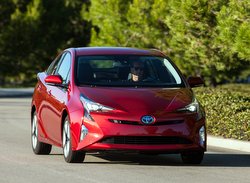
The most obvious change is the startling styling. The new Prius is longer, lower, and wider, but not like the mammoth late 1950s American cars. It’s a radical interpretation of the now classic Prius proportions, with a squinting face and a finned tail. Thanks partially to that shape, the new car has one of the lowest cds (coefficient of drag) in the industry–0.24.
Since the second generation 2004 Prius, the interior has been space-age and swoopy, but the 2016 model is vastly improved. The sweep of the soft-touch panels from dash to doors is dramatic, and, with a lower cowl and side windows, visibility is better too. The center-mounted instruments sit on a dramatically layered and in piano black panel. My tester’s only odd item was a white plastic center console, which reminded me of a bathroom sink.
Going With More Flow (Display)
The Prius has always provided an energy flow display, but the new one offers two. The center console houses the big, colorful one, but the little one in the
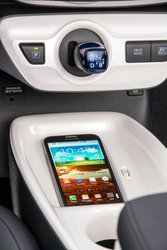
slim band below the windshield helps you monitor when the engine is on. With awareness, you can lift off the accelerator slightly to move from gasoline to electricity. Being always informed lets you drive at the highest efficiency.
As a hybrid, the Prius uses both its 1.8-liter gas engine and two electric motors to move. For 2016, the engine is set to be on less, so the car runs as an EV more. Some components, such as the continuously variable transaxle and power unit, are smaller and lighter, and some body panels, like the hood, are made of lightweight aluminum.
The 2016 Toyota Prius dumps the old nickel-metal hydride battery technology for modern lithium-ion. The battery pack is smaller and flatter, so it fits under the rear seat instead of beneath the cargo area, leaving more cargo space.
More MPG
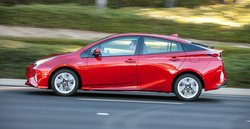
The EPA economy numbers are improved, at 54 city/50 highway/52 combined. I averaged a splendid 57.2 mpg over a busy week. After you turn off the car, the instrument panel briefly displays a rating of your driving efficiency for that trip. I averaged as much as 80.1 mpg a ride. The screen displays a score, say 74/100, and suggests other measures of efficiency, such as lowering the climate control temperature or accelerating more gently. The “Green” numbers on the EPA window label are 7 for Smog and a perfect 10 for Greenhouse Gas.
Unlike a pure electric, the Prius lets you drive as far as you like with great mpg. However, previous models weren’t a great joy to drive, feeling a bit removed from the road. The new model is greatly improved. Built on the Toyota New Global Architecture, it features a high-strength body structure and a double-wishbone independent rear suspension. This, along with a lower center of gravity, makes day-to-day driving much more engaging.
Less Inside (And That’s a Good Thing)
The 2016 Toyota Prius is much quieter inside, thanks to numerous improvements in sound reduction. That benefits listening to music, a necessity for the daily commute grind. My tester featured a
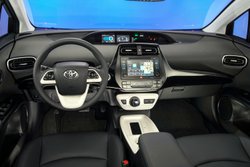
JBL system with 10 GreenEdge speakers. I played music from a variety of sources, including an easy Bluetooth hookup with my iPhone. There’s a charging spot on the console, but it didn’t work on my iPhone. I think it’s better with Androids.
The Prius comes with the new Toyota Safety Sense technology. This includes a pre-collision system with pedestrian detection, lane departure alert, automatic high-beam headlights, and Full-Speed Dynamic Radar Cruise Control. There’s also an Intelligent Parking Assist system available. As you’d expect, the high-tech hybrid is a showcase for Toyota’s other technological breakthroughs.
Prius Comes in Six Flavors
You can get your 2016 Toyota Prius in six flavors. The entry point is the Two, at $25,035. The Three model adds more convenience and technology features, and the Four is the top-of-the-line model. The Two and Three are also available in Eco versions, which use weight-saving and technological tweaks to up the fuel economy a bit. At the top is the Four Touring—the ultimate Prius, at $30,835. All prices shown include the $865 delivery and handling fee.
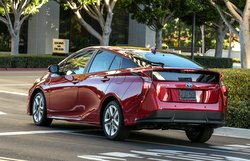
My tester came in a bright new color—Hypersonic Red. A $395 option, it makes the car stand out in traffic. My tester, with the Premium Convenience Package ($1,705) and Advanced Technology Package ($1,935), as well as a Four Season Floor Mat Package ($364) totaled up to $33,884.
The Prius Prime, a plug-in version of the Prius, arrives soon, for even great efficiency.
Today, hybrids have an important role in minimizing carbon emissions into the atmosphere. Driving a Prius is now more efficient and fun. And the extreme styling does grow on you.
Related Stories You Might Enjoy:
Two other perspectives on the 2016 Prius—Larry Hall and Michael Coates
Road Test: 2014 Prius c
Road Test: 2013-14 Honda CR-Z
Road Test: 2017 Honda Accord Hybrid
Road Test: 2016 Hyundai Sonata Hybrid
Road Test: 2016 Toyota Camry Hybrid
Road Test: 2014 Ford Fusion Energi
Disclosure:
Clean Fleet Report is loaned free test vehicles from automakers to evaluate, typically for a week at a time. Our road tests are based on this one-week drive of a new vehicle. Because of this we don’t address issues such as long-term reliability or total cost of ownership. In addition we are often invited to manufacturer events highlighting new vehicles or technology. As part of these events we may be offered free transportation, lodging or meals. We do our best to present our unvarnished evaluations of vehicles and news irrespective of these inducements.
Our focus is on vehicles that offer the best fuel economy in their class. We also feature those that are among the top mpg vehicles in their class. In addition, we aim to offer reviews and news on advanced technology and the alternative fuel vehicle market. We welcome any feedback from vehicle owners and are dedicated to providing a forum for alternative viewpoints. Please let us know your views at publisher@cleanfleetreport.com.

0 thoughts on “Road Test: 2016 Toyota Prius”